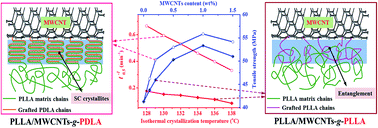Constructing stereocomplex structures at the interface for remarkably accelerating matrix crystallization and enhancing the mechanical properties of poly(l-lactide)/multi-walled carbon nanotube nanocomposites
Abstract
In recent years, there has been growing interest in developing poly(L-lactide)/carbon nanotube (PLLA/CNT) nanocomposites due to their considerable application value and potential. Unfortunately, the fabrication of high-performance PLLA/CNT nanocomposites still faces several obstacles mainly related to the low crystallization rate of the PLLA matrix as well as poor interfacial adhesion between the matrix and CNTs. In this work, we demonstrate a facile and promising route to simultaneously address these limitations by compositing PLLA with poly(D-lactide) grafted multi-walled carbon nanotubes (MWCNTs-g-PDLA) which can be synthesized via in situ ring-opening polymerization of D-lactide on the MWCNT surface. During melt-mixing of PLLA with the as-prepared MWCNTs-g-PDLA, the grafted PDLA chains and PLLA matrix chains tend to arrange side by side at the composite interface and finally co-crystallize into stereocomplex (SC) crystallites capable of serving as not only a highly active nucleating agent to dramatically accelerate matrix crystallization but also an effective interfacial enhancer to greatly improve the interfacial stress transfer efficiency. As a result, PLLA/MWCNTs-g-PDLA nanocomposites exhibit a much higher matrix crystallization rate and mechanical strength as compared to PLLA/MWCNTs-g-PLLA counterparts, where only limited physical entanglement between grafted and matrix chains forms across the interface. Moreover, both the crystallization rate and mechanical strength can be readily manipulated by tailoring the length of the grafted PDLA chains. This work could provide access to design advanced PLLA-based nanocomposites with fast matrix crystallization ability and outstanding mechanical properties via constructing multifunctional SC crystal structures at the interface.


 Please wait while we load your content...
Please wait while we load your content...